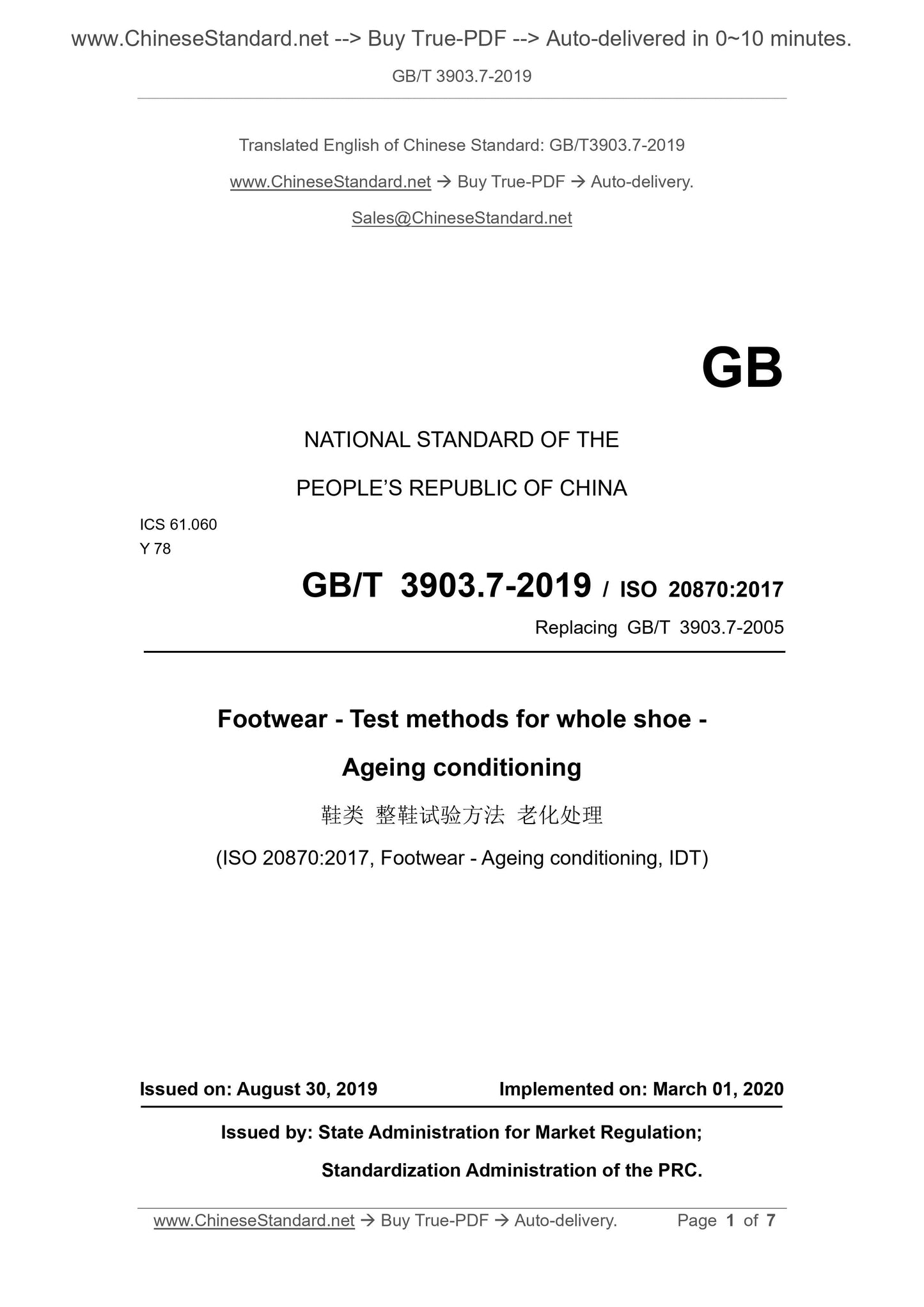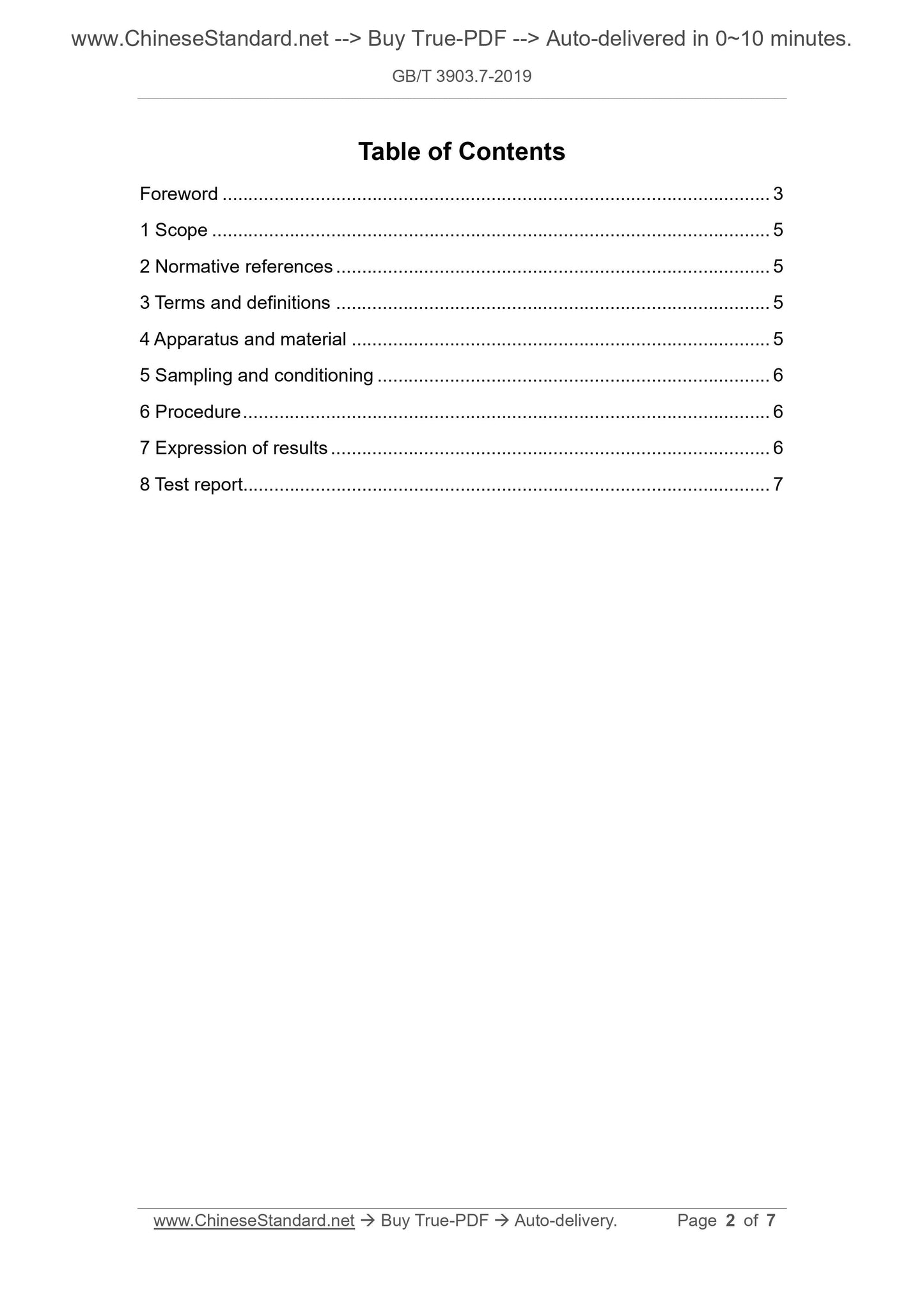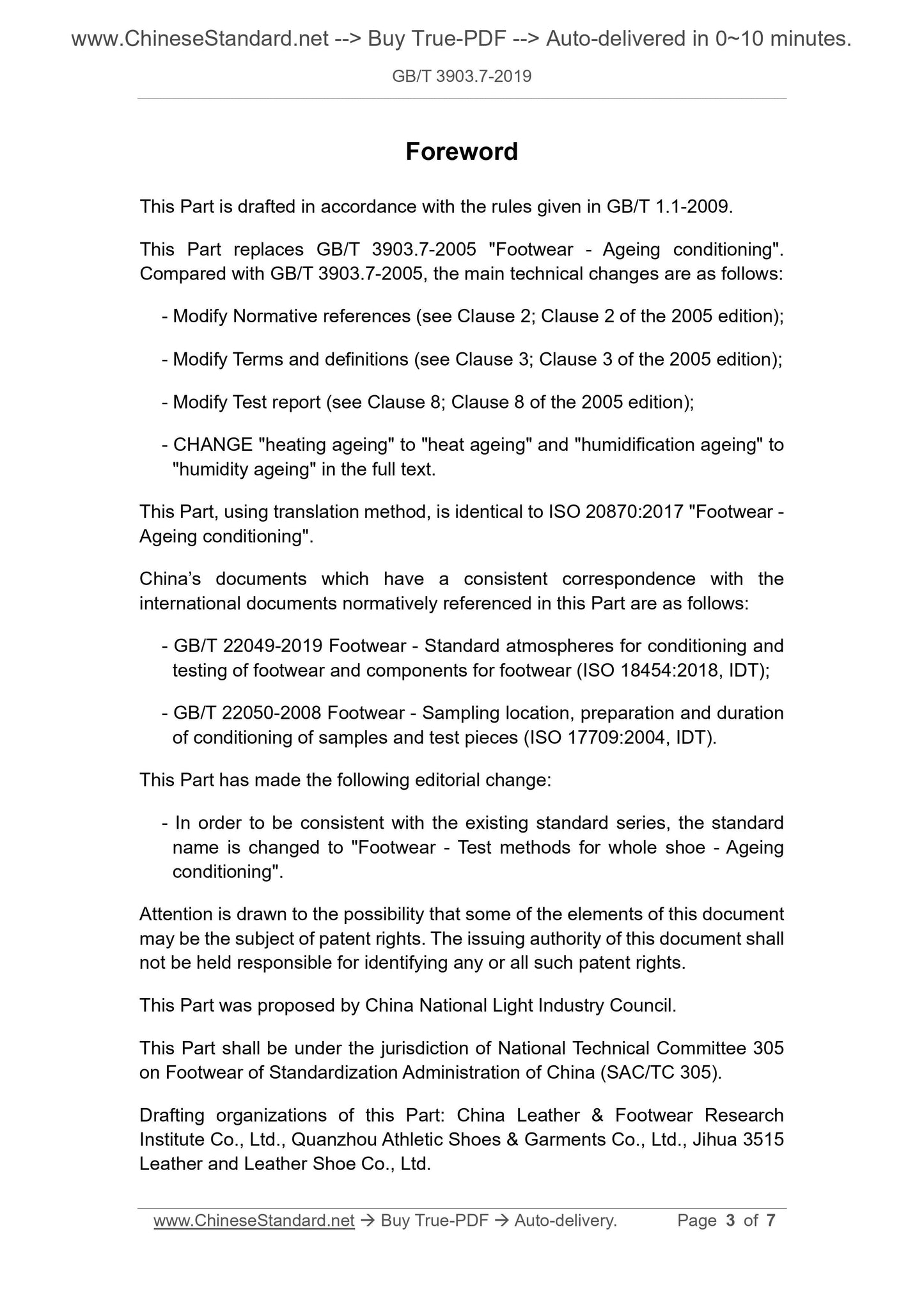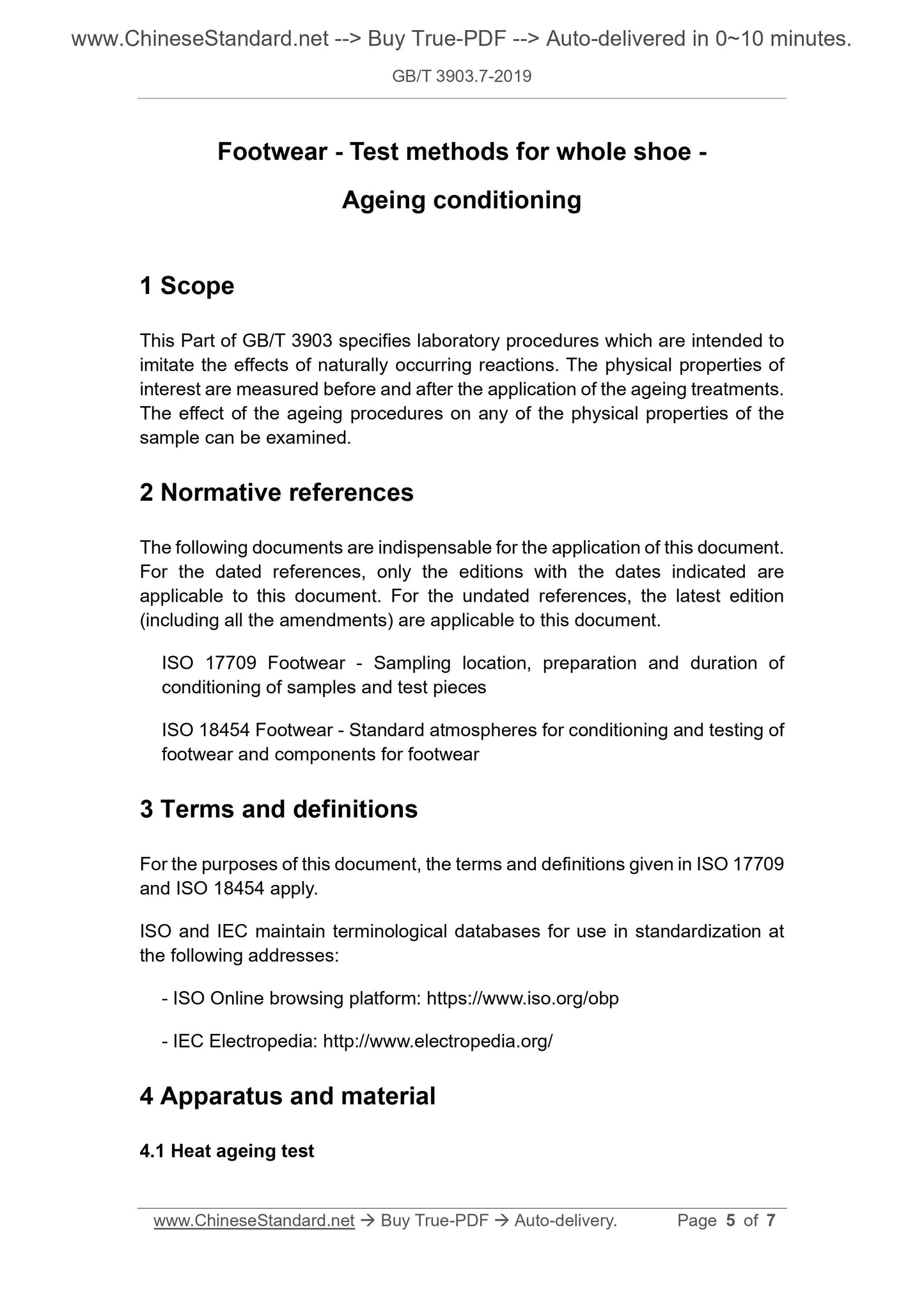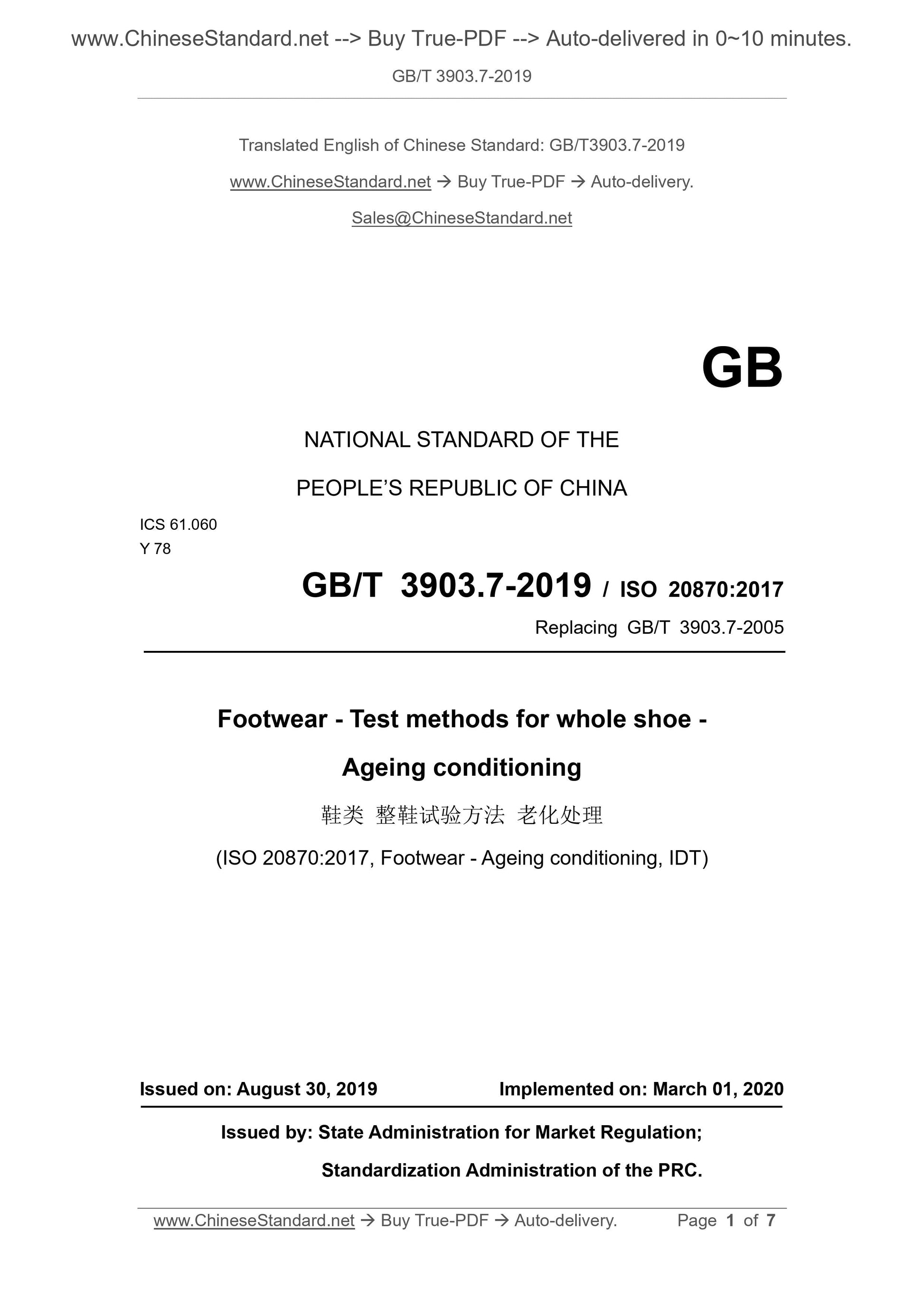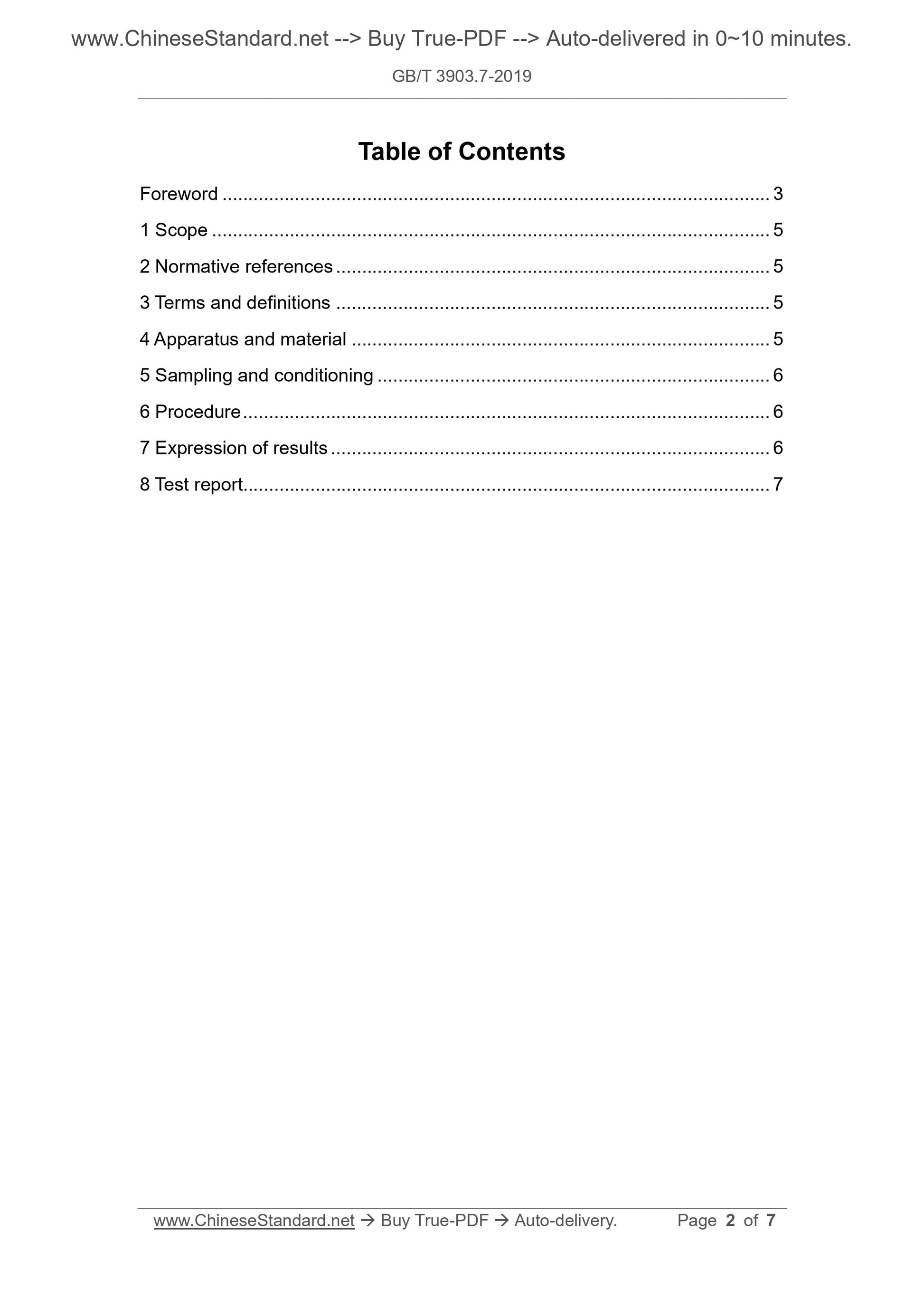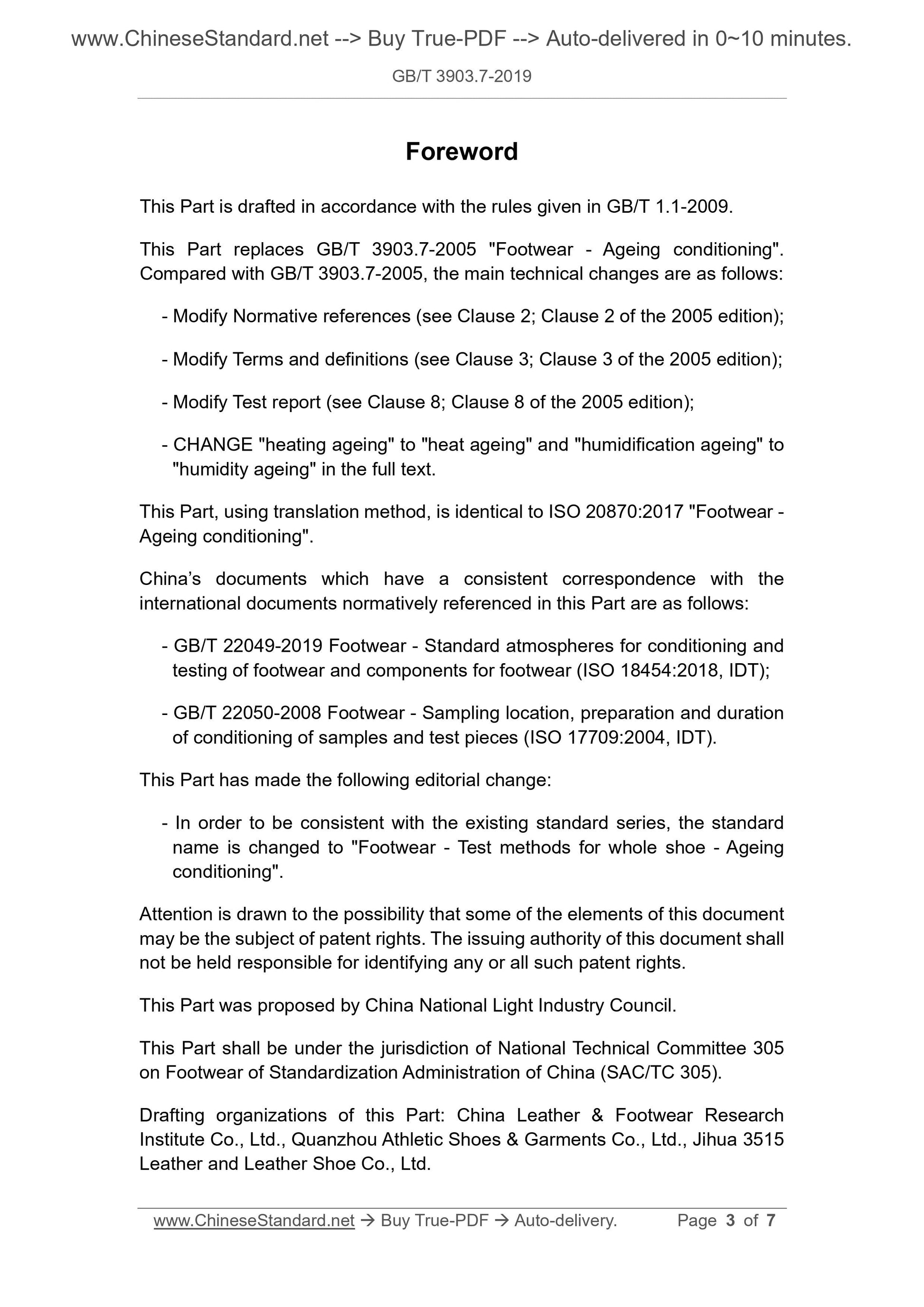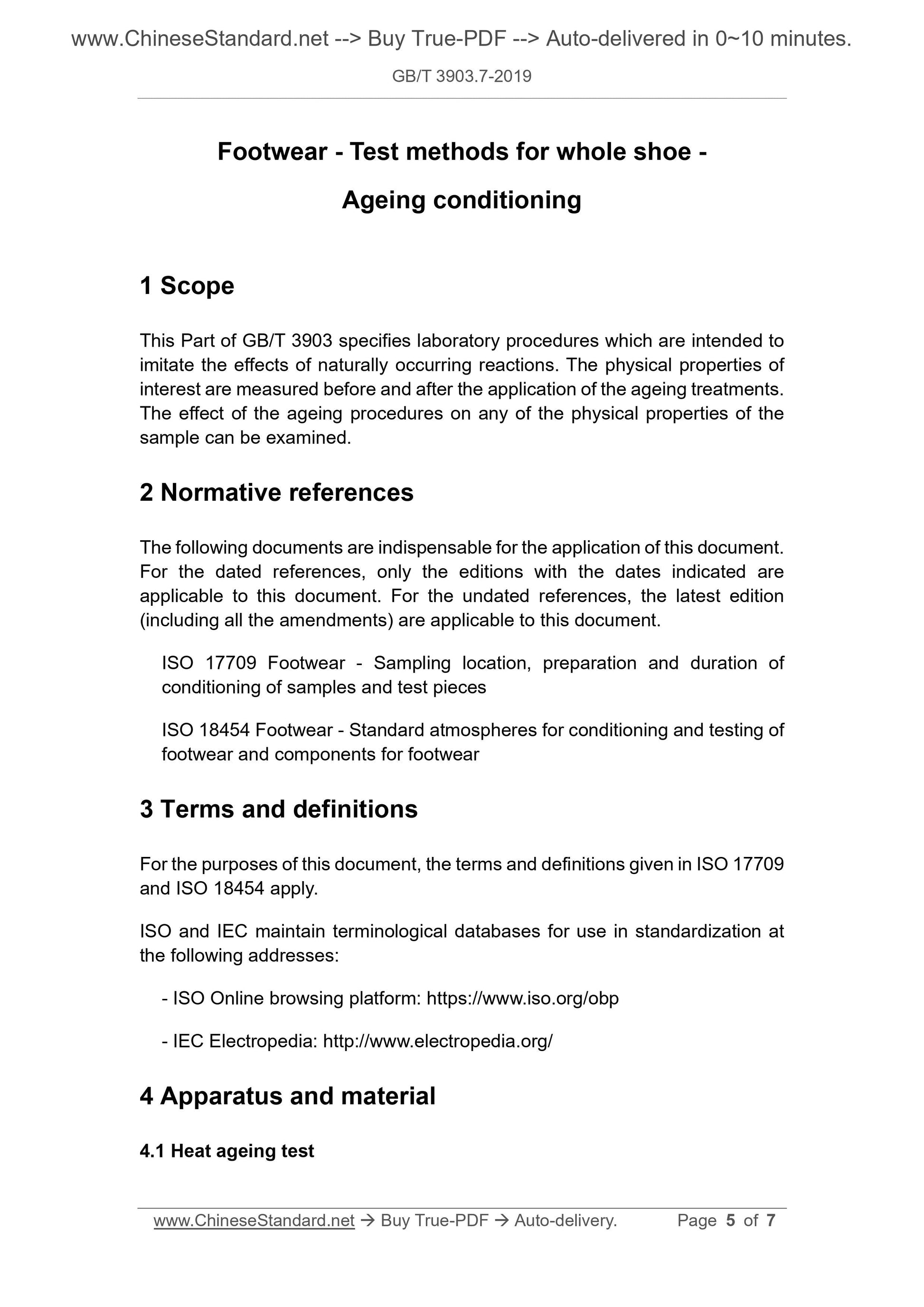1
/
of
4
PayPal, credit cards. Download editable-PDF and invoice in 1 second!
GB/T 3903.7-2019 English PDF (GBT3903.7-2019)
GB/T 3903.7-2019 English PDF (GBT3903.7-2019)
Regular price
$95.00 USD
Regular price
Sale price
$95.00 USD
Unit price
/
per
Shipping calculated at checkout.
Couldn't load pickup availability
Delivery: 3 seconds. Download true-PDF + Invoice.
Get QUOTATION in 1-minute: Click GB/T 3903.7-2019
Historical versions: GB/T 3903.7-2019
Preview True-PDF (Reload/Scroll if blank)
GB/T 3903.7-2019: Footwear -- Test methods for whole shoe -- Ageing conditioning
GB/T 3903.7-2019
Footwear - Test methods for whole shoe - Ageing conditioning
ICS 61.060
Y78
National Standards of People's Republic of China
Replace GB/T 3903.7-2005
Footwear test method
(ISO 20870.2017, Footwear-Ageingconditioning, IDT)
Published on.2019-08-30
2020-03-01 implementation
State market supervision and administration
China National Standardization Administration issued
Foreword
This part is drafted in accordance with the rules given in GB/T 1.1-2009.
This part replaces GB/T 3903.7-2005 "Aging treatment of general test methods for footwear", compared with GB/T 3903.7-2005, the main
The technical changes are as follows.
--- Revised the normative reference document (see Chapter 2, Chapter 2 of the.2005 edition);
--- Revised terms and definitions (see Chapter 3, Chapter 3 of the.2005 edition);
--- Revised the test report (see Chapter 8, Chapter 8 of the.2005 edition);
--- The full text changes "heating aging" to "dry heat aging"; "humidification aging" is modified to "wet heat aging".
This section uses the translation method equivalent to ISO 20870.2017 "shoe aging treatment".
The documents of our country that have a consistent correspondence with the international documents referenced in this part are as follows.
---GB/T 22049-2019 Standard environment for environmental conditioning and testing of footwear footwear and footwear components (ISO 18454.2018,
IDT);
---GB/T 22050-2008 Sampling position, preparation and environmental adjustment time of footwear samples and samples (ISO 17709.2004,
IDT).
This section has made the following editorial changes.
--- In line with the existing standard series, the standard name was changed to "aging treatment of footwear whole shoes test method".
Please note that some of the contents of this document may involve patents. The issuing organization of this document is not responsible for identifying these patents.
This part was proposed by the China Light Industry Federation.
This part is under the jurisdiction of the National Technical Committee for the Standardization of Footwear (SAC/TC305).
This section drafted by. China Leather Shoes Research Institute Co., Ltd., Quanzhou Ryukyu Shoes Co., Ltd., Jihua 3515 leather shoes
Limited.
The main drafters of this section. Shao Lijun, Yang Yumei, Zhou Sujing, Chen Jingyi, Wu Ting.
The previous versions of the standards replaced by this section are.
---GB/T 3903.7-2005.
Footwear test method
1 Scope
This part of GB/T 3903 specifies test methods for simulating the effects of naturally occurring reactions. Determination of the sample before and after the aging treatment
Physical properties. The effect of aging treatment on any physical properties of the sample may be determined.
2 Normative references
The following documents are indispensable for the application of this document. For dated references, only dated versions apply to this article.
Pieces. For undated references, the latest edition (including all amendments) applies to this document.
ISO 17709 Sampling position, preparation and environmental conditioning time for footwear samples and specimens (Footwear-Samplinglocation,
Preparationanddurationofconditioningofsamplesandtestpieces)
ISO 18454 Standard environment for environmental conditioning and testing of footwear footwear and footwear components (Footwear-Standardatmospheres
Forconditioningandtestingoffootwearandcomponentsforfootwear)
3 Terms and definitions
The terms and definitions defined by ISO 17709 and ISO 18454 apply to this document.
The ISO and IEC standardized terminology database addresses are as follows.
4 Test equipment and materials
4.1 Dry heat aging test
4.1.1 The oven has a forced circulation system that maintains the temperature within the range of (70 ± 2) °C.
4.2 Damp heat aging test
4.2.1 Aging test equipment shall be sized to ensure that the total volume of the sample does not exceed 10% of the free air space. The sample is completely free to stretch,
All parts of the sample are in aging air and placed in the dark.
4.2.2 Glass container, placed in a glass container with a suitable plug to place the sample, so that the sample to be tested is in the air with a relative humidity of 100%, with water
Use a bath or oven to heat the glass container and keep it at (70 ± 2) °C.
5 Sampling and environmental conditioning
The selection of the number, size and shape of the sample is determined by the nature of the test, and the specific test specified in ISO 17709 prior to the aging test.
The sample size is sampled.
6 test steps
Physical properties are measured after environmental conditioning, and the specimens should be placed in an aging environment immediately. Dry heat aging process and wet heat
The time of the process is (168 ± 2) h.
After the aging treatment, the sample was adjusted for 24 h according to ISO 18454 before the test.
7 test results expression
The rate of change X of the sample performance is expressed as a percentage (%) and is calculated according to formula (1).
X=
Xa-X0
X0 ×
100% (1)
In the formula.
Xa---the average performance value after aging;
X0---the average performance value before aging.
8 test report
The test report should include the following.
a) the number of this part;
b) detail the nature of the sample;
c) a reference to this test method;
d) test results, as indicated in Chapter 7;
e) indicates whether it is a dry heat aging test or a damp heat aging test;
f) determine its individual performance before and after aging, and indicate the change in performance as a percentage, where appropriate;
g) the date of the test;
h) Standard environmental conditions observed during the test.
Get QUOTATION in 1-minute: Click GB/T 3903.7-2019
Historical versions: GB/T 3903.7-2019
Preview True-PDF (Reload/Scroll if blank)
GB/T 3903.7-2019: Footwear -- Test methods for whole shoe -- Ageing conditioning
GB/T 3903.7-2019
Footwear - Test methods for whole shoe - Ageing conditioning
ICS 61.060
Y78
National Standards of People's Republic of China
Replace GB/T 3903.7-2005
Footwear test method
(ISO 20870.2017, Footwear-Ageingconditioning, IDT)
Published on.2019-08-30
2020-03-01 implementation
State market supervision and administration
China National Standardization Administration issued
Foreword
This part is drafted in accordance with the rules given in GB/T 1.1-2009.
This part replaces GB/T 3903.7-2005 "Aging treatment of general test methods for footwear", compared with GB/T 3903.7-2005, the main
The technical changes are as follows.
--- Revised the normative reference document (see Chapter 2, Chapter 2 of the.2005 edition);
--- Revised terms and definitions (see Chapter 3, Chapter 3 of the.2005 edition);
--- Revised the test report (see Chapter 8, Chapter 8 of the.2005 edition);
--- The full text changes "heating aging" to "dry heat aging"; "humidification aging" is modified to "wet heat aging".
This section uses the translation method equivalent to ISO 20870.2017 "shoe aging treatment".
The documents of our country that have a consistent correspondence with the international documents referenced in this part are as follows.
---GB/T 22049-2019 Standard environment for environmental conditioning and testing of footwear footwear and footwear components (ISO 18454.2018,
IDT);
---GB/T 22050-2008 Sampling position, preparation and environmental adjustment time of footwear samples and samples (ISO 17709.2004,
IDT).
This section has made the following editorial changes.
--- In line with the existing standard series, the standard name was changed to "aging treatment of footwear whole shoes test method".
Please note that some of the contents of this document may involve patents. The issuing organization of this document is not responsible for identifying these patents.
This part was proposed by the China Light Industry Federation.
This part is under the jurisdiction of the National Technical Committee for the Standardization of Footwear (SAC/TC305).
This section drafted by. China Leather Shoes Research Institute Co., Ltd., Quanzhou Ryukyu Shoes Co., Ltd., Jihua 3515 leather shoes
Limited.
The main drafters of this section. Shao Lijun, Yang Yumei, Zhou Sujing, Chen Jingyi, Wu Ting.
The previous versions of the standards replaced by this section are.
---GB/T 3903.7-2005.
Footwear test method
1 Scope
This part of GB/T 3903 specifies test methods for simulating the effects of naturally occurring reactions. Determination of the sample before and after the aging treatment
Physical properties. The effect of aging treatment on any physical properties of the sample may be determined.
2 Normative references
The following documents are indispensable for the application of this document. For dated references, only dated versions apply to this article.
Pieces. For undated references, the latest edition (including all amendments) applies to this document.
ISO 17709 Sampling position, preparation and environmental conditioning time for footwear samples and specimens (Footwear-Samplinglocation,
Preparationanddurationofconditioningofsamplesandtestpieces)
ISO 18454 Standard environment for environmental conditioning and testing of footwear footwear and footwear components (Footwear-Standardatmospheres
Forconditioningandtestingoffootwearandcomponentsforfootwear)
3 Terms and definitions
The terms and definitions defined by ISO 17709 and ISO 18454 apply to this document.
The ISO and IEC standardized terminology database addresses are as follows.
4 Test equipment and materials
4.1 Dry heat aging test
4.1.1 The oven has a forced circulation system that maintains the temperature within the range of (70 ± 2) °C.
4.2 Damp heat aging test
4.2.1 Aging test equipment shall be sized to ensure that the total volume of the sample does not exceed 10% of the free air space. The sample is completely free to stretch,
All parts of the sample are in aging air and placed in the dark.
4.2.2 Glass container, placed in a glass container with a suitable plug to place the sample, so that the sample to be tested is in the air with a relative humidity of 100%, with water
Use a bath or oven to heat the glass container and keep it at (70 ± 2) °C.
5 Sampling and environmental conditioning
The selection of the number, size and shape of the sample is determined by the nature of the test, and the specific test specified in ISO 17709 prior to the aging test.
The sample size is sampled.
6 test steps
Physical properties are measured after environmental conditioning, and the specimens should be placed in an aging environment immediately. Dry heat aging process and wet heat
The time of the process is (168 ± 2) h.
After the aging treatment, the sample was adjusted for 24 h according to ISO 18454 before the test.
7 test results expression
The rate of change X of the sample performance is expressed as a percentage (%) and is calculated according to formula (1).
X=
Xa-X0
X0 ×
100% (1)
In the formula.
Xa---the average performance value after aging;
X0---the average performance value before aging.
8 test report
The test report should include the following.
a) the number of this part;
b) detail the nature of the sample;
c) a reference to this test method;
d) test results, as indicated in Chapter 7;
e) indicates whether it is a dry heat aging test or a damp heat aging test;
f) determine its individual performance before and after aging, and indicate the change in performance as a percentage, where appropriate;
g) the date of the test;
h) Standard environmental conditions observed during the test.
Share
